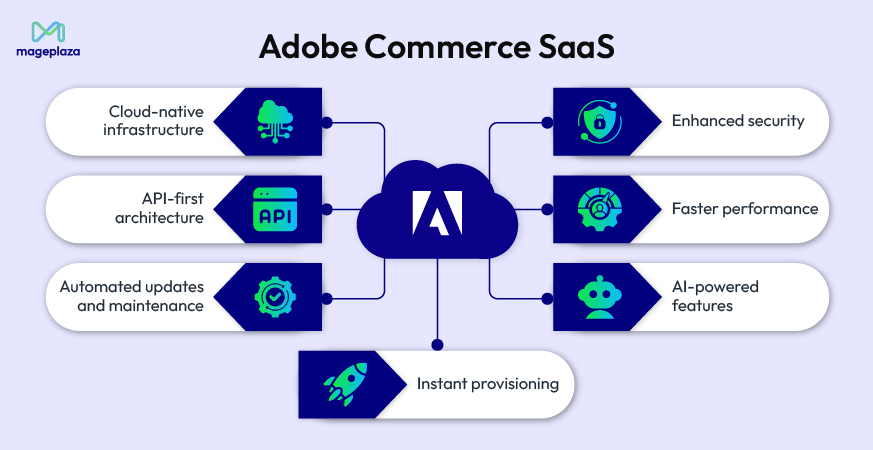Adobe Commerce SaaS or Magento 3? The Future of Magento

Magento has been a trusted platform for building online stores for many years. After Adobe acquired Magento, there have been ongoing discussions about where the platform is headed. Even with recent updates like the Magento 2.4.8 release, it’s clear that Adobe is focusing more and more on long-term cloud strategy. With Adobe pushing forward with Adobe Commerce as a Cloud Service, many users wonder if this move signals the end of traditional Magento or if we might eventually see something called “Magento 3”.
In this blog, we’ll explain what Adobe Commerce as a Cloud Service is, why Adobe is moving in this direction, and what it means for current Magento users. We’ll also take a look at the ongoing conversation around Magento 3 — and whether it’s something we should expect or just a label the community has created.
What is Adobe Commerce SaaS?

Adobe Commerce as a Cloud Service is a cloud-based eCommerce solution built on Magento’s strong foundation. It’s designed to make managing an online store simpler, faster, and more efficient compared to traditional hosting solutions.
Key features of Adobe Commerce SaaS:
- Cloud-native infrastructure: Adobe Commerce SaaS leverages cloud-native technologies for elastic auto-scaling, ensuring your store handles fluctuating traffic seamlessly without manual adjustments.
- API-first architecture: With comprehensive REST APIs and GraphQL APIs, merchants can easily connect third-party tools and customize workflows without touching the core codebase.
- Automated updates and maintenance: Regular automatic updates significantly reduce the IT workload, which allows merchants to focus more on growth and customer experience.
- Enhanced security: Continuous monitoring, regular security patches, and advanced threat detection safeguard businesses against vulnerabilities.
- Faster performance: Built-in CDN services ensure your store loads quickly for customers, no matter where they are in the world. If you’re new to CDNs, this guide explains how to configure a CDN in Magento 2.
- AI-powered features: From smart merchandising to personalized product recommendations, Adobe leverages AI to help merchants boost customer engagement and conversion rates.
- Instant provisioning: Setting up new stores or environments is quick and easy — no more long deployment times.
Goodbye, Traditional Frontend (Luma & Hyva)
One of the most notable changes is Adobe’s move away from Magento’s traditional frontend themes, including Luma theme and Hyva theme. Instead, it introduces Adobe Commerce Storefront, which is a headless and open-source solution.
Why is this important? With a headless commerce, the frontend (what customers see) is completely separated from the backend (where the business logic happens). This allows businesses to have complete freedom over their frontend design, ensuring more personalized and tailored experiences for customers. This also supports the growing trend of omnichannel experiences, where businesses can deliver a seamless shopping journey across multiple touchpoints—websites, mobile apps, social media, and more—without being limited by the traditional Magento frontend.
While this shift means that themes like Luma and Hyva will no longer be compatible, it opens the door for more modern, customizable frontend experiences that can evolve with customer expectations.
Why Adobe is Moving Toward SaaS?

Adobe’s move toward a SaaS reflects a broader industry trend where cloud services are becoming essential for agility, launching faster, and lowering long-term costs. So, why is Adobe moving to a SaaS model for Adobe Commerce? There are several reasons behind this strategic decision.
- Performance issues: Magento stores can become slow, especially when they rely on heavy customizations or complex third-party extensions. Running on a cloud-native setup helps reduce these performance issues.
- High maintenance costs: The traditional model required frequent manual updates and patching, which were both costly and time-consuming. With SaaS, updates happen automatically, so teams can focus on more important tasks.
- Security risks: Open-source platforms can be vulnerable if not properly maintained. With Adobe managing the cloud environment, security is enhanced through consistent monitoring and controlled updates.
- Inconsistent development practices: The decentralized nature of Magento customization sometimes led to code quality issues. A SaaS model enforces stricter standards and centralized management, reducing the risk of unstable customizations.
- Faster deployment: Deploying a new store or feature used to take days or weeks. Now, with instant provisioning and better tooling, businesses can launch faster and adapt quickly.
Magento 3: Evolution or Just a Nickname?
There’s a lot of buzz around the term “Magento 3” in the eCommerce community. While Adobe has not officially rebranded the new platform as Magento 3, many developers and agencies refer to Adobe Commerce SaaS by that name. So, is Magento 3 a true evolution of Magento or merely a nickname?
Rumors or Reality?
Technically speaking, Adobe Commerce as a Cloud Service is not called Magento 3, but its underlying architecture and features represent a significant leap from Magento 2. The platform now operates on an API-first model, features a headless frontend, and adopts an all-in-one cloud-managed approach. This shift aligns closely with what many expected a “Magento 3” to be: a modern, agile solution that addresses many of the long-standing issues of its predecessor. In practice, while Magento 2 remains supported for those who need deep customization and full code control, the future of Magento for most merchants seems to be moving toward the SaaS model.
What Does This Mean for Existing Magento Merchants?
If you’re already using Magento, you might be wondering what all of this means for you. The good news is that Magento 2 (both Open Source and Adobe Commerce) will continue to be supported in the foreseeable future. Adobe will still provide updates and security patches for Magento 2, so merchants who need more customization or control can continue using the platform.
However, it’s important to start considering migration to Adobe Commerce as a Service if you want to future-proof your business. Adobe’s shift toward SaaS means several important things:
- Planning your transition: You’ll need to consider how you move from your current setup to Adobe’s cloud service, which may involve migration steps and careful planning.
- Budget adjustments: Transitioning to SaaS involves changing your spending from upfront investments to monthly subscription costs, making expenses more predictable.
- Learning new skills: Your team might need training on new cloud-based technologies and APIs.
- Quicker innovation: SaaS allows businesses to adopt new features and technologies quickly without managing complicated updates themselves.
Final Thoughts: The Future of Magento Is SaaS
It’s clear that Adobe sees the future of Magento in its cloud-based, SaaS model. While the community often refers to this evolution as “Magento 3,” Adobe hasn’t made that name official—and likely never will. Still, the changes happening under the hood show real progress: faster updates, better performance, and easier ways to manage and scale.
For merchants, this means it’s time to start thinking about what’s next. Whether or not you’re ready to move today, it’s smart to understand how Adobe Commerce as a Cloud Service works and what it can offer. The move to SaaS isn’t just a trend—it’s a shift toward more flexible, secure, and scalable eCommerce. And it’s where Magento is headed.






![Top 20+ Must-have Shopify Apps for 2025 [Free & Paid] - Mageplaza](https://cdn2.mageplaza.com/media/blog/must-have-shopify-apps/top-must-have-shopify-apps.png)
![[2025 Updates] Top 10+ Upsell Apps for Shopify - Mageplaza](https://cdn2.mageplaza.com/media/blog/best-upsell-shopify-app/cover.png)
